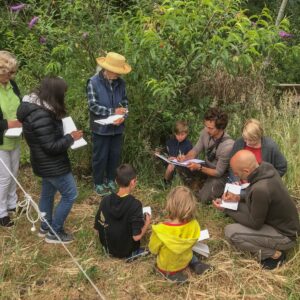Do you want to learn how to nature journal? Do you want to avoid the most common beginner mistakes? Right now, I show you 10 steps to getting started with nature journaling.
How to Nature Journal
- First, choose your location wisely. Choose a location that is close, convenient, and comfortable. This is a common mistake that beginners and experienced nature journalers both make. You don’t need the most exciting wilderness location to nature journal.
- Next, get your supplies ready. One mistake that many of us make is to get more art supplies than we really need. All you really need is a good bag, a sketchbook, a pencil, and whatever you need to be comfortable in nature. For a review of what I use see Journaling Kit Review
- Capture the context quickly. Whip your nature journal out and start using it as soon as possible. A common mistake is to wander around for too long waiting for inspiration. There is no perfect subject and the muse will not come to you if you don’t get some pencil miles first. Start by putting metadata, sketching a map, or getting other contextual information on the page.
- Warm up your brain with “I notice, I wonder, it reminds me of.” Before you get caught up in trying to paint a portrait of a bird or flower start with this simple observation exercise. In this way you will warm up your observation skills and you will breach the barrier of the blank page.
- Now, draw a landscapito or paint a scene. Drawing a small landscape or scene will convey the feeling and ecology of a place. These will help you remember your trip and they look great on the page combined with your other notes and drawings. However, there are also side benefits of sitting still this long. Birds and animals often come close! For more on drawing landscapitos see these videos
“The real voyage of discovery consists not of seeing new landscapes but in having new eyes”
–Marcel Proust
Next 5 Steps
- Draw a Diagram. The next step is to draw a diagram of something that you are curious about. By making it a diagram you take the pressure off of it being a pretty picture. Use arrows, words, and numbers to add information that you can not convey with the image itself.
- Ask more questions. This is one of the most powerful tools of nature journaling. By practicing asking questions we sharpen our ability to learn new things.
- Stop before you are done. While you might be tempted to push yourself at first it is actually best to stop while you are still having fun. Start by giving yourself short outings that leave you wanting more. Like the small servings at a fancy restaurant.
- Get yourself an Ice Cream. Now that you have completed a session of nature journaling get yourself a reward. You deserve it and by rewarding yourself you will help ingrain this new habit.
- Review your work and share it: When you get home you can accelerate your learning by reviewing it, researching further, and getting feedback from others. What do you notice about your pages? What could be better? Can you think of more questions? Are there parts you would like to add color to now that you are home? Are there things you want to research further? Now is also a time that you could draw more detailed drawings based on photos you took on the outing, especially of fast moving birds or insects that you could not capture in the field. Sharing online and getting feedback from other nature journalers will also help you a lot.
